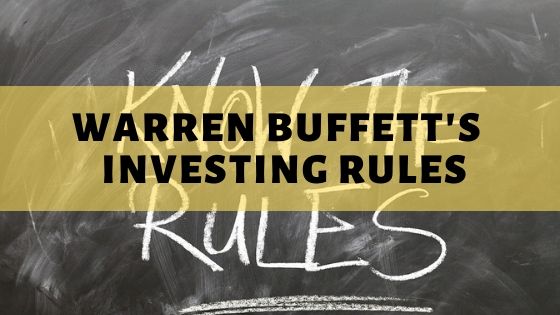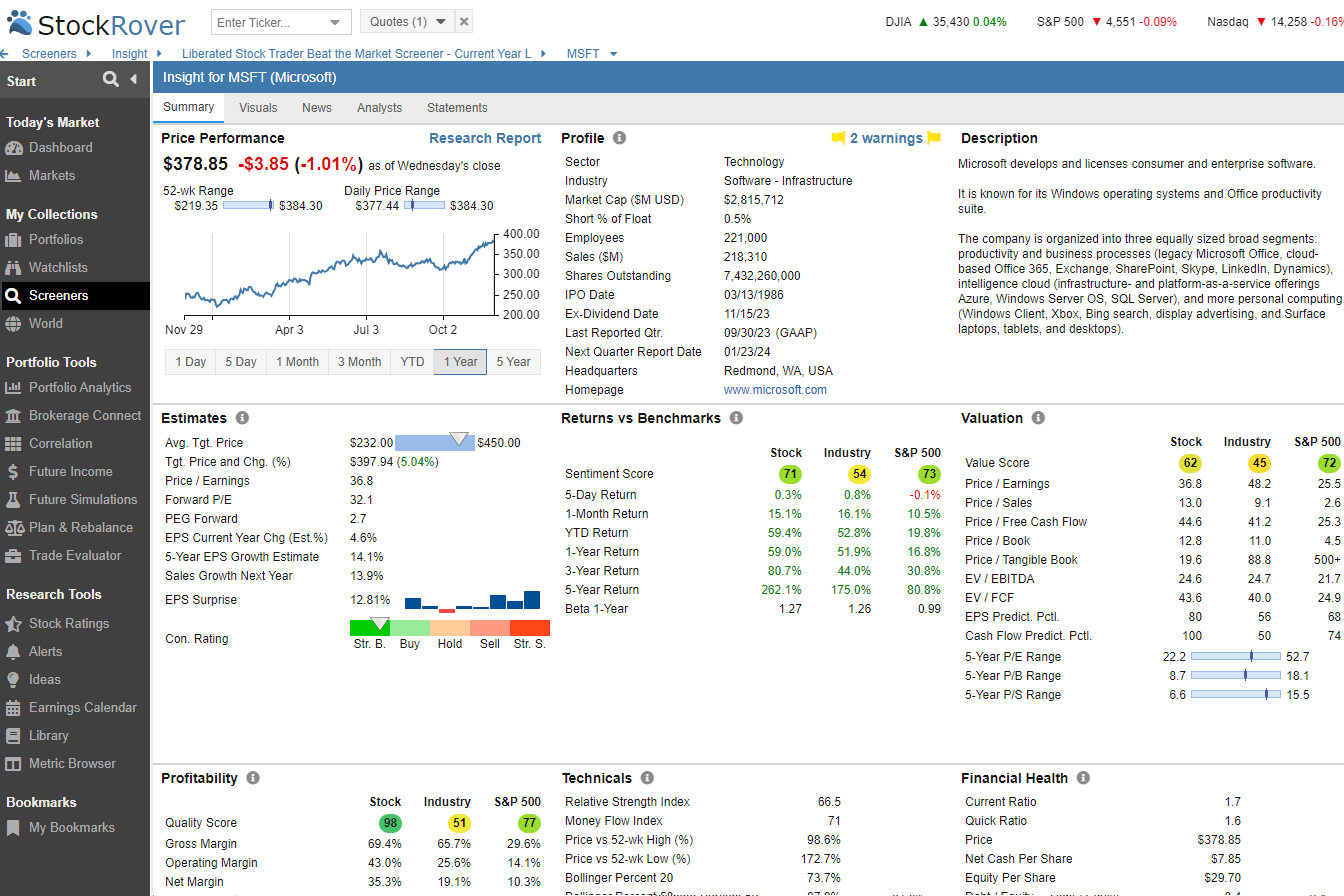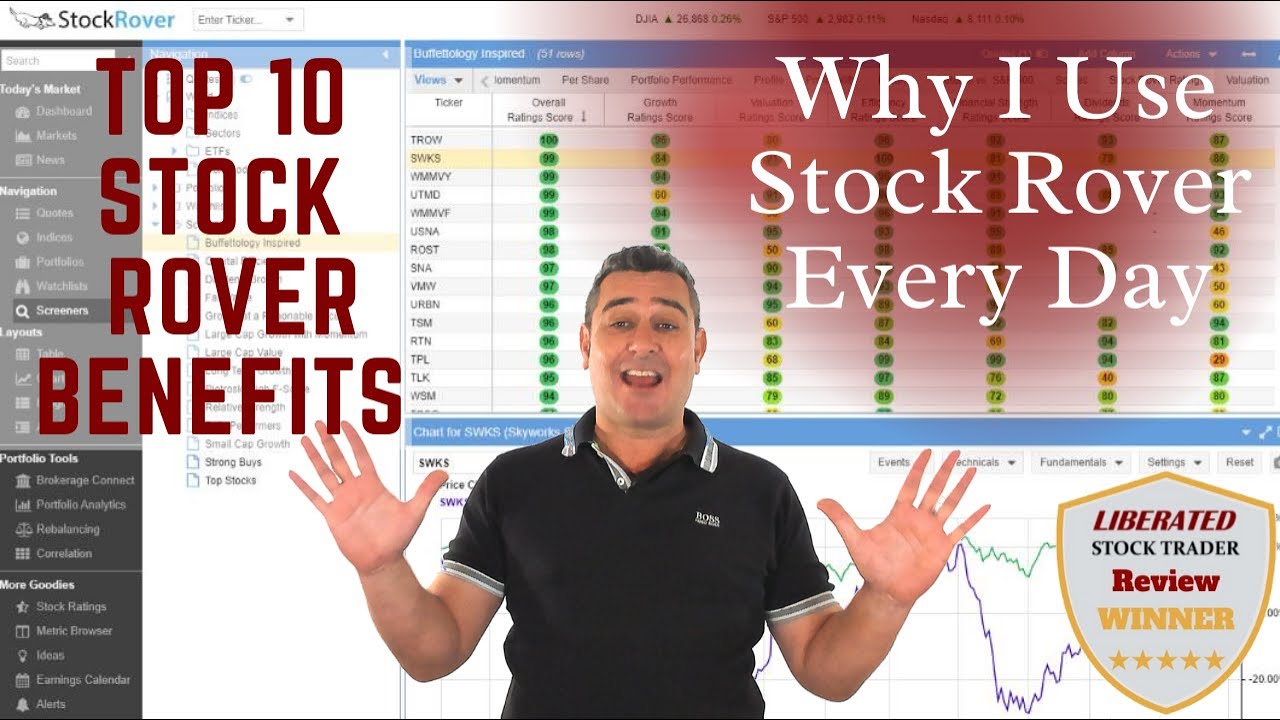Warren Buffett’s rules of investing include “Never lose money,” “Always have a margin of safety,” and “Be fearful when others are greedy, and greedy when others are fearful.” This timeless wisdom will help you be a better investor.
But how do you implement Buffett’s rules? Join me as I explain each rule and how to practically implement his advice.

The most detailed analysis of Buffett’s investing rules is outlined in the book “The New Buffettology” by his daughter Mary Buffett. We combine this study, his letters to Berkshire Hathaway shareholders, TV interviews & Buffett’s Own Book “The Snowball.”
In addition to this information, we include the two most important criteria his mentor, the great Benjamin Graham, created: Fair Value (Intrinsic Value) and Margin of Safety.
Warren Buffett’s Investing Rules
- Rule 1. Never Lose Money
- Rule 2. Never Forget Rule Number 1
- Rule 3. Always Have A Margin of Safety
- Rule 4. Find Companies With Good Financials
- Rule 5. Find Companies With Good Earnings
- Rule 6. A Consistently High Return on Equity
- Rule 7. Does the Company Earn a High Return on Total Capital?
- Rule 8. Is the Company Conservatively Financed?
- Rule 9. Does the Company Earn More Money Than Bonds?
Rule 1. Never lose money.
Renowned for his cautious investment approach, Warren Buffett is fondly remembered for his prudent words. He strikes a chord as a risk-averse investor who meticulously seeks profitable opportunities while sidestepping unnecessary risks.
Rule 2. Never forget rule number 1.
Warren Buffett emphasizes the significance of prioritizing low-risk investments as he underscores the golden rule: “Never lose money.” The core idea is to avoid unnecessary gambles regarding your financial ventures.
Rather, focus on acquiring shares of companies that excel in prominent markets, generating substantial profits. Above all, seize the opportunity to acquire stocks at discounted prices. The subsequent principles cover all of these crucial aspects.

Try Powerful Financial Analysis & Research with Stock Rover
Rule 3. Always have a margin of safety.
The margin of safety is all about reducing the risk of an investment. The bigger the discount you can get when buying a share of a company, the less risk you have because how far further could the stock price fall?
If a stock price is significantly below the company’s fair value, that percentage difference is known as the Margin of Safety. Essentially, the percentage that the stock market undervalues a company.
If you understood a business perfectly and the future of the business, you would need very little in the way of a margin of safety. So, the more vulnerable the business is, assuming you still want to invest in it, the larger the margin of safety you’d need. If you’re driving a truck across a bridge that says it holds 10,000 pounds and you’ve got a 9,800 pound vehicle, if the bridge is 6 inches above the crevice it covers, you may feel okay; but if it’s over the Grand Canyon, you may feel you want a little larger margin of safety – Warren Buffett
In other words, the Margin of Safety is the percentage difference between a company’s Fair Value per share and its actual stock price. If a company’s profits and assets outweigh its stock market valuation, this represents a Margin of Safety for the investor. The higher the margin of safety, the better.
In classic value-investing theory, the margin of safety is the level of risk an investor can live with. The margin of safety estimates the risk a stock buyer takes.
Rule 4. Find companies with good financials.
From interviews, lectures, and his history of stock purchases, it is no secret that Buffett looks for great companies making robust and growing profits in markets where they have a competitive advantage. Here, we will look at some of the critical signs of companies with good fundamentals.
If a business does well, the stock eventually follows. Warren Buffett
Businesses making regular profits and controlling their costs in an industry where they have an advantage will eventually be discovered by Wall Street analysts, and the stock will rise accordingly.
Investing In Stocks Can Be Complicated, Stock Rover Makes It Easy.
Stock Rover is our #1 rated stock investing tool for:
★ Growth Investing - With industry Leading Research Reports ★
★ Value Investing - Find Value Stocks Using Warren Buffett's Strategies ★
★ Income Investing - Harvest Safe Regular Dividends from Stocks ★

"I have been researching and investing in stocks for 20 years! I now manage all my stock investments using Stock Rover." Barry D. Moore - Founder: LiberatedStockTrader.com
Rule 5. Find companies with good earnings.
A strong record of earnings and growth rates is a key indicator of a sound business. It is no surprise that Warren Buffett and Wall Street place significant importance on profitability. Buffett seeks out companies with a consistent history of earnings growth, particularly spanning over a 5 to 10-year period.
However, he does not excessively fixate on quarterly earnings results. He believes the investment analyst community and the media’s excessive attention to short-term outcomes can harm long-term business prospects.
Rule 6. Look for a consistently high return on equity.
The profitability measure, Return on Equity (ROE), calculates net income as a percentage of shareholders’ equity. A high ROE signifies the efficient utilization of investor funds, resulting in the growth of the business’s value.
Focus on return on equity, not earnings per share. Warren Buffett
This refers to focusing on the value of a company, not the speed of their earnings increases.
Rule 7. Does the company earn a high return on capital?
Total capital includes debt and equity. A company’s ability to generate a high return on total capital indicates its use of debt and the overall health of its business model. Companies with low leverage tend to perform better in the long term than heavily leveraged companies.
Return on Invested Capital (ROIC) quantifies how well a company generates cash flow relative to the capital it has invested in its business.
It is defined as Net Operating Profit after Taxes / (Total Equity + Long-term Debt and Capital Lease Obligation + Short-term Debt and Capital Lease Obligation)
Building the Best Buffett Stock Screener for Value Investing
Rule 8. Is the company conservatively financed?
An ideal company has no short-term debt and is well-capitalized with plenty of cash. Companies with too much leverage are more susceptible to the vagaries of business cycles, which can lead to bankruptcy if a company’s sales and profits suffer due to external economic conditions. Also, companies that rely too heavily on debt may not have enough free cash flow to reinvest in their business.
The Debt/Equity ratio measures a company’s leverage (debt) relative to its equity and should be kept at a reasonably low level. A good guideline is for companies with Debt/Equity ratios of no more than 1.5.
For a company to pull out of any business difficulties it may encounter, it needs plenty of financial power. Companies with a durable competitive advantage usually create such great wealth for their owners that they are long-term-debt-free or close to it. Standard debt-to-equity ratios give a poor picture of the business’s financial strength in that shareholder’s equity is seldom used to extinguish the debt. The earning power of a business is the only real measure of a company’s ability to service and retire its debt. You need to ask yourself, how many years of current net earnings would be required to pay off all the long-term debt of the business in the current year? Source The New Buffettology
You can use the closest match, the Solvency Ratio, to achieve this precise calculation.
The solvency ratio measures whether a company generates enough cash to stay solvent. It is calculated by summing net income and depreciation and dividing by current liabilities and long-term debt. A value above 20% is considered good.
Rule 9. Does the company earn more money than bonds?
A company is said to be earning more than its bonds if the return on equity exceeds a bond’s coupon rate. A company earning more money than its debt has greater control over its destiny and provides higher returns for shareholders.
To calculate this ratio, divide the return on equity (ROE) by the weighted average.
The initial rate of return for the stock needs to be higher than the yield on U.S. Treasury bonds.
If a company cannot make a profit per share higher than the return of a safe asset like treasury bonds, you should not invest in it. This is a straightforward calculation, and we will use the Earnings Yield. Earnings Yield is the earnings per share for the most recent 12-month period divided by the current market price per share.
Rule 10. Does the company have an economic moat?
The most successful companies in the world have something that others don’t: a durable competitive advantage. This edge will make it difficult for competitors to catch up and potentially earn above-average returns for you, the investor.
Examining its economic moat is one way to determine if a company has this edge. This measure of the strength of its competitive advantage can be calculated by examining factors like revenue growth, profitability, market share, customer loyalty, brand power, cost structure, and others.
Better technology, products, patents, or even a captive market might give the company a competitive advantage over others in the industry. Does the company’s industry, for example, have high barriers to entry, such as a microchip maker or telecoms company? Also, remember that it is a durable competitive advantage, meaning it will last at least ten years.
Rule 11. Do you understand how the product works?
Buffett firmly believes that a prerequisite for investment is a comprehensive understanding of the product or service. Without this understanding, accurately evaluating potential threats or competition becomes impossible. Thus, it is crucial to grasp the intricacies of the business before making any investment decisions.
Never invest in a business you can’t understand
His preference is to exclusively invest in companies that he can comprehend.
Rule 12. Avoid companies that might be obsolete in 20 years.
Buffett is aware that some technological innovations can disrupt entire industries. He says that even if a company has a competitive advantage today, it may not last forever. Thus, he recommends avoiding companies whose core products or services might become obsolete within the next 20 years. This includes all high-tech companies and those with rapidly changing business models, as they’re more prone to disruption from
If the company has a durable competitive advantage and you understand how it works, what is the chance it will become obsolete in the next twenty years?
Time is the friend of the wonderful company, the enemy of the mediocre. Warren Buffett
Mediocre companies will eventually lose out to fitter and stronger companies. An excellent company with a competitive advantage and long-term profitability will win over time.
This one may be tough to quantify; it will require you to think forward and use your visionary skills to assess if the company will be replaced by new technology, better services, or archived due to consumer preferences.
Rule 13. Does the company allocate capital exclusively in the realm of its expertise?
Long-term success requires companies to invest in their core competencies and strengths. Companies allocating capital outside their expertise or industry could struggle to stay afloat.
Diversification is a protection against ignorance. It makes very little sense for those who know what they’re doing. Warren Buffett
Buffett does not like companies that try to diversify into markets they do not understand. A term coined by the investing legend Peter Lynch, “Diworsification” refers to precisely the phenomena of a company trying to expand into markets and services that are not central to its expertise. There is plenty of evidence that this type of expansion is usually bad for business and future profits.
Rule 14. Is the company free to raise prices with inflation?
If a company faces intense competition that drives down the prices of its products or services, it might be wise to avoid investing in its stock.
In such cases, it’s important to consider the impact of stagnant prices during inflation and factor this into your business evaluation and the Margin of Safety calculations.
Rule 15. Are large capital expenditures ahead?
Large capital expenditures can disrupt a company’s financial health and may result in reduced dividend payments or other value-reducing activities. It’s important to determine if such expenditures and their purpose are planned for the near future. Additionally, large, unplanned costs should be considered when assessing a company’s risk profile.
Industries such as automotive and telecommunications require significant infrastructure and equipment investments to maintain a competitive edge. It is crucial to be aware of impending major expenditures.
Rule 16. Be fearful when others are greedy and greedy when others are fearful.
Timing the purchase of stocks is crucial for maximizing value capture. A valuable approach to determine this is examining the company’s dividend payment history and track record of consistent share price growth.
Additionally, assessing whether the company’s stock price is affected by market panic, business recession, or any resolvable individual calamity is important.
This is the magic question and the question that leads to Buffett’s famous quote.
BE FEARFUL WHEN OTHERS ARE GREEDY, AND BE GREEDY WHEN OTHERS ARE FEARFUL – Warren Buffett
If the market is going through panic, a stock with great company fundamentals (financials), low competition, and a substantial competitive advantage could see its stock price fall dramatically. This would be a great time to buy, as you will see a higher Margin of Safety.
Rule 17. Is the company actively buying back its shares?
Warren Buffett pays close attention to companies that engage in share buybacks. This action reflects the management’s optimism about the company’s potential and suggests that the stock market is undervalued.
Such circumstances are often seen as a promising indication with undeniable positive implications.
Rule 18. Buy a simple business at a fair price.
This is an excellent insight into why many businesses begin to fail when the third generation of family owners takes over. So, “a business that is so simple any idiot can run it” is a maxim that reminds us of the risks of nepotism.
I try to invest in businesses that are so wonderful that an idiot can run them. Because sooner or later, one will. Warren Buffett
The point is that anyone can run a great business as long as the business fundamentals remain the same.
Rule 19. Be a long-term investor.
Warren emphasizes the importance of long-term focus, exemplifying how it can ease people’s worries about their investments and allow them to direct their energy toward building a prosperous future.
Our favorite holding period is forever. Warren Buffett
In the short term, the market is a popularity contest. In the long term, the market is a weighing machine. Warren Buffett
The media and Wall Street constantly promote fashionable stocks; Buffett rebels against this popularity contest. The weighing machine refers to the fact that good companies’ market dominance and profitability will mean eventually, they will be valued highly.
Widespread fear is your friend as an investor because it serves up bargain purchases. Warren Buffett
This is a jibe at how wrong most investors are. For example, when everyone around you talks about investing in Cryptocurrencies, it is probably time to sell. Moreover, when everyone is complaining about the massive crash in the Crypto market, it could be time to buy.
Rule 20. The best time to sell is never.
Warren Buffett’s famous words hold regardless of the economic climate: as an investor, it’s crucial not to rush into selling. Instead, if a company’s fundamentals are robust, holding onto your shares for as long as possible is wise. This approach ensures better opportunities for long-term prosperity and growth.
One of my favorite quotes from the Oracle of Omaha. However, the fact is that Buffett does sell, but the vast majority of the time, he is accumulating stock.
Mastering Value Investing: A Complete Strategy Workbook +pdf
Final Thoughts
Buffett’s investing strategy is based on several key principles, which ultimately boil down to being patient and rational when making decisions. Firstly, he emphasizes the importance of being aware of the bigger picture and not getting overly caught up in short-term news or trends.
Secondly, it is important to base investment decisions on facts instead of speculation. Finally, when evaluating a stock, one should look for companies with strong fundamentals that could hold up well over time.
In addition to these rules, Buffett also advocates diversifying investments to minimize risk. He believes in focusing on long-term growth instead of simply chasing short-term gains. As a result, his investing style has been highly successful over time, as evidenced by his massive fortune and historical track record of outperforming the market.

A perfect example of diworsifcation is Amazon taking over Whole Foods. Whole Foods has never been worse.